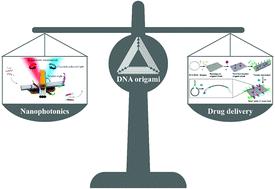Our official English website, www.x-mol.net, welcomes your
feedback! (Note: you will need to create a separate account there.)
DNA origami: an outstanding platform for functions in nanophotonics and cancer therapy
Analyst ( IF 3.6 ) Pub Date : 2021-2-3 , DOI: 10.1039/d0an02160a Lizhi Dai 1, 2, 3, 4, 5 , Peng Liu 1, 2, 3, 4, 5 , Xiaoxue Hu 1, 2, 3, 4, 5 , Xiaozhi Zhao 4, 5, 6, 7, 8 , Guoqiang Shao 5, 9, 10, 11, 12 , Ye Tian 1, 2, 3, 4, 5
Analyst ( IF 3.6 ) Pub Date : 2021-2-3 , DOI: 10.1039/d0an02160a Lizhi Dai 1, 2, 3, 4, 5 , Peng Liu 1, 2, 3, 4, 5 , Xiaoxue Hu 1, 2, 3, 4, 5 , Xiaozhi Zhao 4, 5, 6, 7, 8 , Guoqiang Shao 5, 9, 10, 11, 12 , Ye Tian 1, 2, 3, 4, 5
Affiliation

|
Due to the proposal and evolution of the DNA origami technique over the past decade, DNA molecules have been utilized as building blocks for the precise construction of nanoscale architectures. Benefiting from the superior programmability of DNA molecules, the sequence-dependent recognition mechanism and robust complementation among DNA strands make it possible to customize almost arbitrary structures. Such an assembly strategy bypasses some of the limits of conventional fabrication methods; the fabrication accuracy and complexity of the target product are unprecedentedly promoted as well. Furthermore, due to the spatial addressability of the final products, nanostructures assembled through the DNA origami technique can also serve as a versatile platform for the spatial positioning of functional elements, represented by colloidal nanoparticles (NPs). The subsequent fabrication of heterogeneous functional nanoarchitectures is realized via modifying colloidal NPs with DNA strands and manipulating them to anchor into DNA origami templates. This has given rise to investigations of their novel properties in nanophotonics and therapeutic effects towards some diseases. In this review, we survey the crucial progress in the development of DNA origami design, assembly and structural analysis and summarize available applications in nanophotonics and cancer therapy based on the object-dressed DNA origami complex. Moreover, we elucidate the development of this field and discuss the potential directions of this kind of application-oriented nanomanufacturing.
中文翻译:

DNA折纸:在纳米光子学和癌症治疗中发挥作用的出色平台
由于DNA折纸技术的提出和发展,在过去的十年中,DNA分子已被用作构建纳米级结构的基础。得益于DNA分子的出色可编程性,依赖于序列的识别机制以及DNA链之间的强大互补性使得定制几乎任意结构成为可能。这样的组装策略绕开了传统制造方法的一些限制;目标产品的制造精度和复杂性也得到空前提高。此外,由于最终产品的空间可寻址性,通过DNA折纸技术组装的纳米结构还可以用作功能性元素在空间上定位的通用平台,由胶体纳米颗粒(NPs)代表。实现了异质功能纳米体系结构的后续制造通过用DNA链修饰胶体NP并操纵它们以锚定到DNA折纸模板中。这引起了对它们在纳米光子学中的新特性以及对某些疾病的治疗作用的研究。在这篇综述中,我们调查了DNA折纸设计,组装和结构分析的发展中的关键进展,并总结了基于对象修饰的DNA折纸复合体在纳米光子学和癌症治疗中的可用应用。此外,我们阐明了该领域的发展,并讨论了这种面向应用的纳米制造的潜在方向。
更新日期:2021-02-17
中文翻译:

DNA折纸:在纳米光子学和癌症治疗中发挥作用的出色平台
由于DNA折纸技术的提出和发展,在过去的十年中,DNA分子已被用作构建纳米级结构的基础。得益于DNA分子的出色可编程性,依赖于序列的识别机制以及DNA链之间的强大互补性使得定制几乎任意结构成为可能。这样的组装策略绕开了传统制造方法的一些限制;目标产品的制造精度和复杂性也得到空前提高。此外,由于最终产品的空间可寻址性,通过DNA折纸技术组装的纳米结构还可以用作功能性元素在空间上定位的通用平台,由胶体纳米颗粒(NPs)代表。实现了异质功能纳米体系结构的后续制造通过用DNA链修饰胶体NP并操纵它们以锚定到DNA折纸模板中。这引起了对它们在纳米光子学中的新特性以及对某些疾病的治疗作用的研究。在这篇综述中,我们调查了DNA折纸设计,组装和结构分析的发展中的关键进展,并总结了基于对象修饰的DNA折纸复合体在纳米光子学和癌症治疗中的可用应用。此外,我们阐明了该领域的发展,并讨论了这种面向应用的纳米制造的潜在方向。











































 京公网安备 11010802027423号
京公网安备 11010802027423号